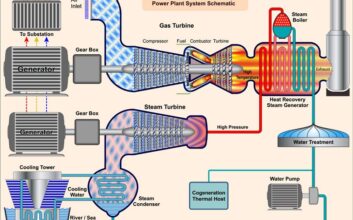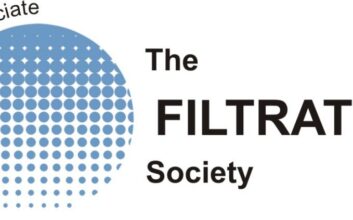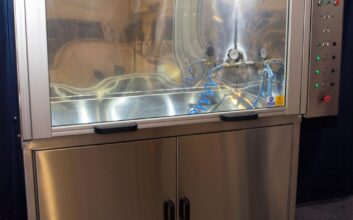Test standard EN 779:2012 (1) has been superseded by a new standard ISO 16890:2016 (2). An important part of both standards is to measure the minimum efficiency of a filter, which is also referred to as the ‘discharged efficiency’.
In standard EN 779:2012, a discharged filter is achieved by dipping a flat sheet media sample into liquid IPA (isopropanol) for two minutes and then leaving it to dry for 24 hours. In the new standard ISO 16890:2016, a full size filter element is discharged by placing it into a specially designed cabinet and exposing it to IPA vapour for 24 hours.
Aim
The aim of this study was to investigate how the efficiency of an air filter changes when exposed to IPA vapour for different lengths of time up to 24 hours. This was achieved using Particle Technology’s air filter test system, which is used to carry out UKAS accredited tests according to EN 779:2012 and ISO 16890:2016.
Method
Four gas turbine cartridge filters (Micro-Mesh Filtration, Nottingham, UK) were subjected to initial pressure drop and initial efficiency measurements. The test filters were constructed from a cellulose fibre media with a nano-layer coating and had an F9 rating by a third party test facility according to EN 779:2012. The test air flow rate throughout was 1000 m3/hr.
Three filters were then discharged inside an IPA vapour cabinet for different durations up to 24 hours, before repeat measurements of pressure drop and efficiency were made. One of the four filters was used as a reference filter, where the second set of pressure drop and efficiency measurements were performed without having performed a vapour discharge procedure on the filter.
The efficiency measurements were conducted using a DEHS oil mist (DiEthylHexylSebacate, >97.0 % purity) that was generated from a PLG 2000H Laskin nozzle device (Palas, Germany). Upstream and downstream particle concentrations were measured using a Welas 3000H Optical Particle Counter (Palas, Germany). The cabinet used for the IPA vapour discharge was the TDC 584 (TOPAS, Germany) using IPA with a purity of 99.7 %.
Results
The initial pressure drop profiles of the four filters were highly consistent with each other over the range of 500 to 1250 m3/hr, and the remeasurement of pressure drop for the three filters that were exposed to IPA vapour were within an average of 5 Pa of the initial pressure drop values.
Figure 1 shows the initial efficiency curves for the filters in new condition, and the secondary efficiency curves following discharge with IPA vapour for 0, 1, 3 and 24 hours.

The data in Figure 1 shows a good level of consistency between the initial efficiency values of the four filters. A reduction in efficiency was obtained for all filters during the second measurement of efficiency. This includes filter F1, which was simply retested and not exposed to IPA vapour.Table 1 compares the average efficiency values of the filters before and after exposure to IPA vapour, at the standard particle size of 0.4 microns as per EN 779:2012.Table 1 – Comparison of initial and secondary efficiency data at 0.4 microns

* – Filter F1 was used as a reference filter, with no exposure to IPA vapour.
The data in Table 1 shows that after the standard 24 hour exposure time to IPA vapour (filter F2), the efficiency had reduced from 91% to 75% at 0.4 microns. Filter F3, which had been exposed to IPA vapour for just three hours, had also reached a minimum efficiency of 75%. However, the exposure time of just 1 hour (filter F4) had only reduced the efficiency to 77%, which indicated that 1 hour was not sufficient to reach a stable discharged efficiency condition.
Conclusions
This study has shown that an IPA vapour discharge time of 3 hours achieved the same reduction in efficiency as a 24 hour discharge time, and that a 1 hour discharge time was not sufficient to reach a stable discharged efficiency condition.
References
1. EN 779:2012, Particulate air filters for general ventilation – Determination of the filtration performance.
2. ISO 16890:2016, Air filters for general ventilation, Part 4: Conditioning method to determine the minimum fractional test efficiency.
 sales@particletechnology.com
sales@particletechnology.com




